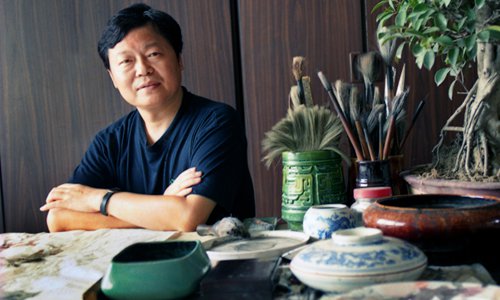
Wang Xijing at his studio. Photo: Courtesy of Wang Xijing
Huang Binhong (1865-1955) is a famous traditional Chinese ink painting artist who introduced contemporary methods into his works. In his later years, he described his paintings saying, "Song Dynasty (960-1279) drawings focus more on the lines and description of tangible sceneries, while Yuan Dynasty (1279-1368) works focus more on the spirits of nature, and no matter how many changes there are in painting, artists must start from painting realistically."
This realistic method of painting is not only a truth in China but also the West, and spans from ancient times to modern day. From ancient Greece to the 20th century to contemporary times, art pioneers like Pablo Picasso, Henri Matisse, Wassily Kandinsky, Piet Mondrian and Salvador Dali all accept the rule of putting the realistic painting method first.
Wang Xijing, a now famous traditional Chinese ink painting artist, began to show his talent in the 1980s. He created many great works like Chuangye Shihua (the story of an entrepreneurship), Yuanqu de Zuyin (disappearing footsteps) and Ah Q Huaya (Ah Q pleads guilty). Wang followed the realistic style of Xu Beihong and Jiang Zhaohe, two Chinese painting masters.
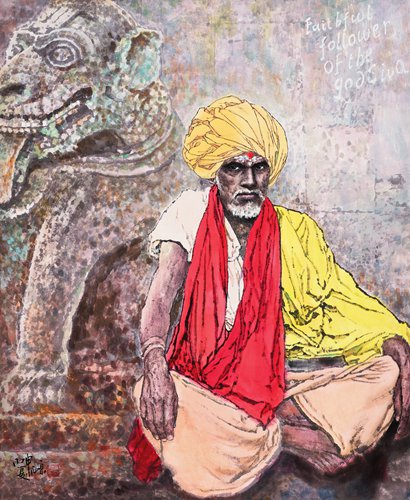
Si Lu Feng Qing Xi Lie, 143 cm x 117 cm 2016
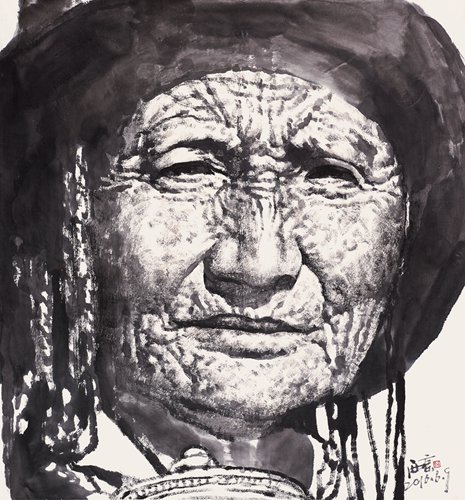
Gao Yuan Mu Qin, 89 cm x 83 cm 2016
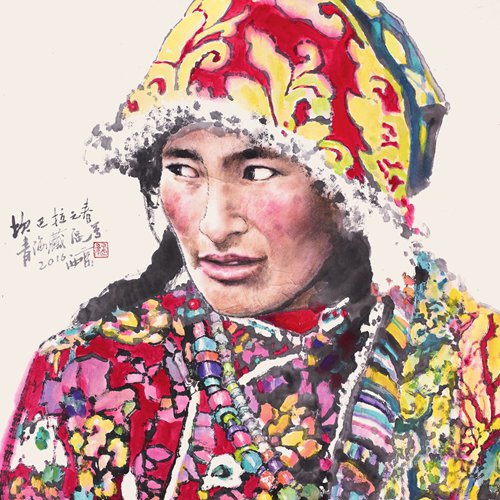
Kan Ba La Zhi Chun, 93 cm x 89 cm 2016
In addition, Wang was praised for his innovation. In the 1980s, there were many schools and new ideas in the painting circle, and Wang's art was successful. Of course, Xu and Jiang's realistic style is very different from photographic realism or hyperrealism.
In the middle of the 1980s, Wang's spectacular works, including the figure paintings of China's revolution leaders, are not only in line with the method of the realistic painting style, but also represent historical authenticity by incorporating a high level of realism.
As a result, his works have a unique spirit and are well known in the field of art. After 10 years of efforts and research, Wang's works gained greater acknowledgment in the 1990s. Qu Qiubai, the painting he drew in 1991 about the famous revolution leader Qu Qiubai and Daqian Guanhetu Baimiaogao, his 1996 work about famous painter Zhang Daqian looking at lotus, were both based on a simple, straightforward style of painting. They have reached the perfect integration of realistic style and free style.
Especially Qu Qiubai, a very valuable masterpiece of figure painting, it is not only unique in conception and setting, but also excellent in art representation. The figure stands in a large blank area. Although the figure takes up a very small portion of the work, it shows the great power of spirits and characteristics of Qu Qiubai.
Another work, Chidu Xinshi (the history of the red city), has 22 lines of calligraphy, which create a grand background of "great red tides and beautiful sunset glows." It means that China has woken up from its 5,000-year long dream.
The audience seems to be able to hear the roars of China's revolution to be independent. The painting can touch people in the deepest place of their heart and trigger great resonance.
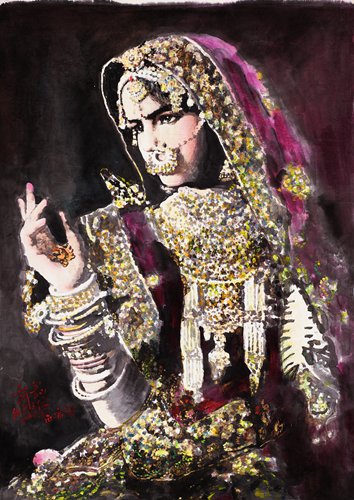
Wu Yun, 131 cm x 93 cm 2016
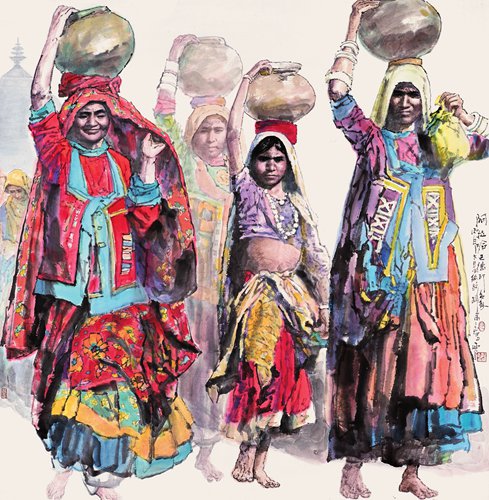
A La Ha Ba De Yin Xiang, 146 cm x 143 cm 2016
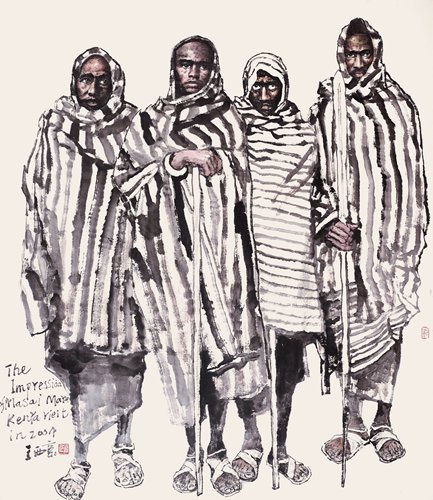
Ma Sai Ma La Yin Xiang, 165 cm x 143 cm 2016
Another branch of Wang's paintings is ancient figure paintings, which is very creative. He is careful in choosing the figures he paints. He mainly chooses outstanding patriotic intellectuals, poets, writers and artists of ideals and integrity. For example, he paints Qu Yuan, Wen Tianxiang, Li Qingzhao, Pu Songling and Zheng Banqiao. In addition, he painted a giant painting of Zhulin Qixian, or the Seven Sages of the Bamboo Grove.
At the same time, Wang also created many poetry paintings. They are based on the integration of realistic style and free style. With poetry and lines on his paintings, they are more readable and easily understood. As a result, Wang is getting more and more outstanding among his peers and his works are getting increasingly influential among his audience and the whole art circle in China.
For example, Zheng Banqiao, an ancient artist and scholar in Qing Dynasty (1644-1911), is famous for his noble character and sterling integrity. In Wang's paintings, such features are fully represented. There are historical, personalized features in Zheng's figure paintings, and they are often thought to be his most thought-provoking works. It may be because Wang and Zheng have many things in common.
After all, Wang has created many excellent figure paintings over 30 years. His painting skills and creative thoughts are the key points to his success, and they are represented in six aspects. The six aspects are rigorous attention, keen observation, sound knowledge, good memory, great imagination and accurate judgment.
These are the elements of his success, and they have created glorious depictions of Wang's way of life with his art. From his paintings, we can see Wang's outstanding comprehension ability and noble and humble heart with high level of aesthetic judgment.
Creating ink figure paintings with both strong traditional Chinese style and modern scenes is a hard but great historical art project, and it needs the continuing efforts of generation after generation.
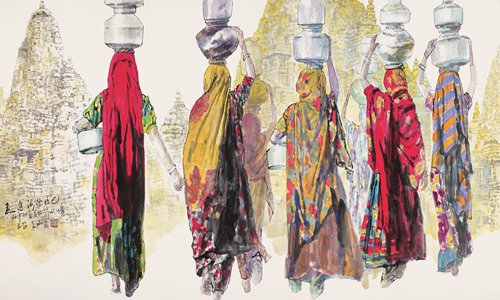
Zou Jin Hai De La Ba, 243 cm x 121 cm 2016
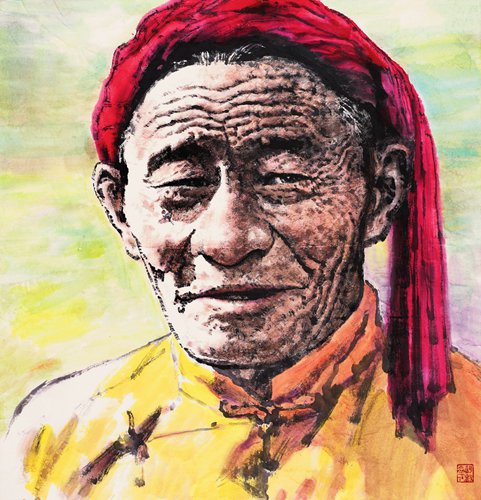
Wu Ming, 92 cm x 89 cm 2016
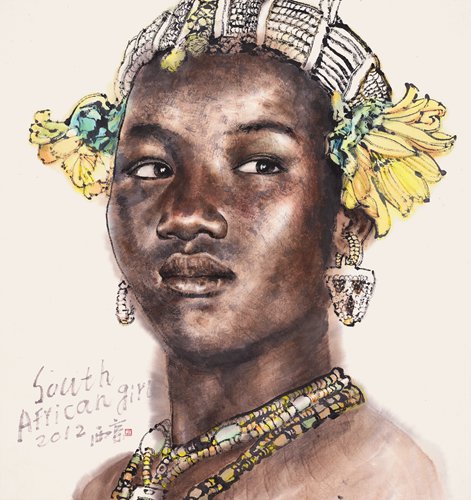
Nan Fei Shao Nü, 89 cm x 84 cm 2016
"The artists of today are lucky because they are in this revolution and in an era which rejuvenates the Chinese nation. I admire the young artists who are good at absorbing new concepts and dare to explore new things. I think they are the mainstream force of traditional Chinese ink painting's modernization," Lu Chen, one of the most important leaders of pioneers of Chinese traditional ink paintings' innovation, said in the 1980s. He was a professor of Central Academy of Fine Arts when he made the comment.
After two decades, there have been numerous innovative works and there will be more. The mainstream development direction of traditional Chinese ink painting is encouraging.
In addition, prestigious artists are still insisting that people keep creating art, and Wang is one of them.
With more than 5,000 great works, Wang is famous and influential in both China and foreign countries. With his vigorous, unconstrained and grand characteristics in his artworks, people can find both great modern energy and the traditional and ancient style, which is unparalleled in history.
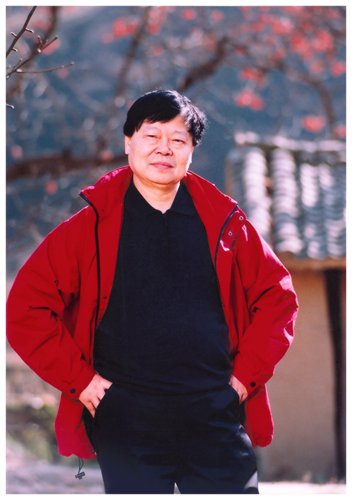
Wang Xijing Photos: Courtesy of Wang Xijing
Artist Introduction
Wang Xijing was born in August 1946 in Xi'an, Shaanxi Province.
His experience includes being a council member of China Artists Association, member of the Traditional Chinese Ink Painting Committee of China Artists Association, deputy director of Chinese Painting Institute and vice chair of Shaanxi Province China Federation of Literary and Art Circles.
In addition, he was chair of Shaanxi Province Artists Association, honorary dean and professor of Xi'an University of Architecture and Technology and professor of Chinese National Academy of Arts, Northwest University, Yunnan University and Xi'an Academy of Fine Arts.
Wang is also a member of the 12th national committee of Chinese People's Political Consultative Conference (CPPCC), and deputy to the 9th and the 10th National People's Congress.
The awards Wang has been granted include National Expert with Outstanding Contribution by the State Council, China Pioneer, Top Ten Most Influential People of China's Revolution, Shaanxi Province Red Banner and Shaanxi Province Industry Leader.
